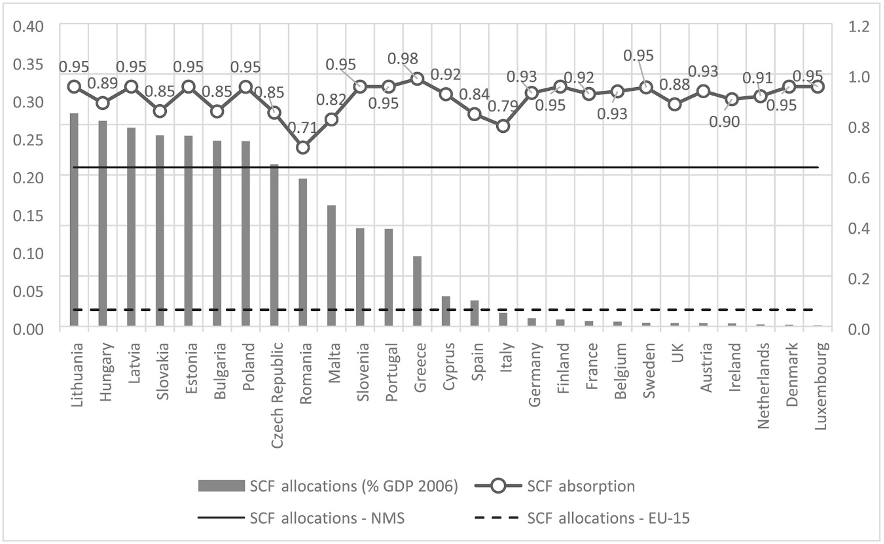Do institutions help achieve greater value for spending European taxpayers’ money?

The European Union (EU) budget is about one percent of the Gross Domestic Product (GDP) of all Member States amounting to about €240 per annum, per citizen. The EU budget redistributes more than €150 billion annually. These funds are directed towards agriculture and regional policy, which operate to help less developed countries and local communities. Millions of euros are spent on rebuilding roads or hospitals or for the educational and vocational training of thousands of European citizens’. A significant proportion of this money goes towards underdeveloped and economically less well-off regions, especially across Southern, Central, and Eastern Europe (see Figure 1).
Background: the issue of EU funds absorption variation
European and national politicians, journalists and citizens have often raised questions on how EU funds are used. The media tends to cover this topic whenever it can frame issues of mismanagement or corruption. It rarely addresses the factors that account for the delivery and spending of EU funds across countries and regions or how Structural and Cohesion Funds (SCF) are absorbed into local economies.
Against this background, our recent article provides a more refined understanding of what factors are driving the absorption of EU funds. Our research is significant because it provides a rich empirical analysis of the differences in EU funds absorption performance across European Union member countries. We help explain why some countries are better at spending European funding than others. In doing so, we examined how administrative and political indicators play out and affect the wider institutional environments responsible, at the national level, for spending a large part of European taxpayers’ money.
It is rather well-known that newer member states have often faced difficulties in absorbing EU funds into their economies. States such as the ones from Central and Eastern Europe had to comply with several EU laws and procedures before joining the EU. Despite a “learning process” achieved during the pre-accession period, some countries still face considerable challenges in accessing Structural and Cohesion Funds (also as can be seen from Figure 1). Looking at the previous multi-annual financial period of 2007-2013, and with few exceptions, three large groups of countries were identified in terms of Structural and Cohesion funds implementation:
- most of the new Member States, with a relatively low absorption capacity, especially in the first period of the Cohesion Policy implementation (with notable outliers such as Lithuania, Estonia and Poland);
- southern periphery Member States such as Italy and Spain which had consistently low absorption rates throughout the period;
- most other EU-15 countries that had a relatively high performance in the early stages of Structural Funds implementation.
Although differences in absorption performance have considerably decreased in the last years, they have generally persisted over the entire programming period of 2007-2013, with significant delays and bottlenecks for several NMS. This is also the case for the current 2014-2020 EU budgetary period.
Figure 1: Allocated Cohesion and Structural Funds (SCF) during the 2007–13 Programming Period and Absorption Rates (2015) in EU‐27 countries.

Core findings and relevance
Two core findings stand out in our article. These help provide answers to the above puzzles on why some countries’ are doing better than others when it comes to spending EU funding.
First, the effectiveness of a countries’ government and the latter’s ability to combat corruption are key factors that could boost a country’s absorption of EU funds. What this means is that the more effective a government is and the more it is willing to curb corrupt practices, within its structures, the more likely it is for that country to do better in spending EU money. Apart from ensuring a functional management and institutional system, Member States also need to prevent the distortions of different interest groups as to ease the implementation of Structural Funds. However, political cartels and corruption are still very present in many European countries, which in turn could affect how the returns of EU funds’ investments, and EU money more generally, are managed.
Second, other elements such as the quality of regulations or and the level of political stability in a country, contrary to our initial expectations, do not seem to matter so much. At the same time, other elements such as the level of political centralisation and decentralisation found and the macro-economic financial absorption capacity of a country, are also not important for what countries manage to get from the common European budget.
Why are these findings relevant? In essence, because they confirm the importance of administrative institutions and political governance in how public resources are managed, something already known in the field. European taxpayers’ money is redistributed, through the European budget, with the honourable aim of helping regions and European citizens in need. There needs to be a more specific focus on how domestic institutions and political forces influence the way public resources are spent. In recent years, politicians, academics and citizens have equally become more aware of this. Our research adds to this chorus of voices arguing that government effectiveness and internal corruption practices require further attention. These might be some of the most practical solutions for strengthening the implementation of Cohesion Policy across all EU Member States.
Conclusions and recommendations for policy-makers
So how could politicians / policy-makers help achieve these aims? Firstly, more steps should be taken to improve the quality of institutions, procedures and human resources managing EU funds. This could be attained through a better use of Technical Assistance funding. Secondly, the question of combating corruption and of greater political support needs to be addressed head-on by all stakeholders. When politicians in the EU Council get together, in the next few months, to decide on the future European budget, these issues should be treated with utmost priority, alongside other technicalities and the increasing dominant discussions regarding the recovery plan needed post-corona.
The idea of a stronger European Union is linked to a common EU budget. Member States need to do more to improve their governmental effectiveness and efficiency, as well as reduce levels of corruption in order to improve spending of EU money. A better use of these resources seems to be highly related to these two factors across almost all EU countries. Advances in these areas might help achieve the wider objectives of European cohesion and solidarity. Eventually, this might also improve citizens’ levels of satisfaction with Europe and their support for the European integration project.
This blog post draws on the JCMS article, ‘Evaluating the Determinants of EU Funds Absorption across Old and New Member States – the Role of Administrative Capacity and Political Governance’.
The blog has originally been posted on the JCMS blog on Ideas on Europe, on the 5th of October, 2020.
The blog has been co-authored with Cristian Incaltarau, researcher at the Centre for European Studies within Alexandru Ioan Cuza University of Iasi (Romania) and Prof Gabriela Carmen Pascariu, full professor in European economics and policies & Director of the Centre for European Studies at Alexandru Ioan Cuza University of Iasi (Romania).